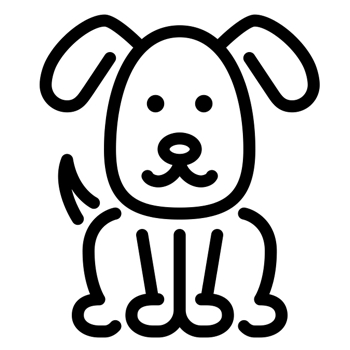Beagi

Also known as the Corgeagle, the Beagi is one of many crossbreeds that has only recently emerged on the scene. Oftentimes too smart for their own good, they can be a bit of a handful and require consistent training. They relish time spent outdoors but owners need to keep a watchful eye on them as they are forever on the hunt for new and interesting smells.
A dog that typically has the tricolor coat of the Beagle and the body shape of the Corgi, this is an attractive hybrid. Some will inherit the endearingly large and floppy ears of their Beagle parent while others will have triangular ears that stand erect, much like the Corgi. Their short fur is low maintenance but can shed a reasonable amount in the warmer months.
About & History
A dog that has only been around for a handful of decades, the Beagi has yet to make a real name for itself and both its personality and reputation are still emerging. Its parents, on the other hand, have hundreds of years of history to their names.
The Corgi
The Corgi is probably best known today for being the breed of choice of the Queen of England. They have a rather unique, portly body shape with a plush, dense coat and very large ears. Native to the UK, there are two variants of the Welsh Corgi; the Pembroke and the Cardigan.
Traditionally, these dogs were used on farms to both herd and drive cattle and were reasonably good guard dogs. They are thus included in the Pastoral group of the Kennel Club. As these dogs have a working background and are relatively easy to train they are often seen partaking in competitive canine activities, such as herding work and obedience.
The Beagle
Beagles are hound dogs that excel at hunting and are mainly used in the pursuit of rabbits and hare. When working, they have good levels of stamina and are committed to the task at hand. Their biddable nature means that they can transition from working dog to pet dog beautifully.
While dogs similar to the Beagle have existed within England for over 500 years, the modern-day Beagle is thought to have been established as recently as the 1800s. Their ancestors include the taller Foxhound, a dog also renowned for its hunting prowess. As Beagles generally hunt in packs they are very sociable dogs and thrive on the companionship of other canines. Nowadays, there are both American and English strains of the Beagle, each having their own breed standard.
Appearance
Beagis typically have short limbs, long barrel-shaped bodies and expressive faces. Their head is in proportion to their body and they have a broad forehead and square muzzle. Their circular eyes are a dark brown and well-spaced apart. Their large leathery nose is always black and is a prominent facial feature. They have thick, muscular necks and they tend to inherit the small, stumpy tails of the Corgi.
Short though solid, the Beagi grows to sizes of between 28cm and 35cm and will weigh somewhere around 9kg to 13kg. While not true for all breed members, most are lucky enough to have the attractive black, white and brown tricolor coat of the Beagle. Some will be just cream and others cream and white. Their fur is thick and short with a double coat.
Character & Temperament
A plucky little chap with lots of character, the Beagi is a self-assured dog not lacking in confidence. They do best with experienced owners who have plenty of time available to dedicate to their training. They can be known for testing their limits and many have a tendency to be willful.
Affectionate with close family members they love nothing more than to cuddle up with their owners after a day full of playing and running about. They can be protective of those they love and will keenly protect them if they sense a threat. In fact, some may act aggressive if they feel someone who doesn’t belong has entered their territory.
These dogs relish the opportunity to be around other dogs and are happiest when homed with a few canine buddies. Other animals, however, are not tolerated as well and rabbits and cats are usually seen as prey rather than extended members of the family.
Trainability
Dogs that have always worked for a living, they are quick to learn and highly motivated. Most are incredibly food driven so treats should be used in abundance during training sessions (just make sure they’re low calorie!). Their stubborn streak can mostly be overcome with persistence and patience. The novice trainer may find these dogs a bridge too far.
Due to their keen sense of smell, training sessions outside may prove challenging as their attention span is limited and they may prefer to follow scent trails than to pay attention to a human!
Health
Being aware of the potential health problems that the Beagi can suffer allows us to be prepared and to attempt to breed them out of the population. There are a number of conditions that we need to consider, including:
Intervertebral Disc Disease (IVDD)
Any dog with a long back is prone to back injury. IVDD is the most common spinal disease that we see in dogs and ‘dwarf’ dogs, such as the Corgi, and their progeny are over-represented. Pain is the most common symptom and those afflicted may also drag their feet or even go off their legs entirely.
Imaging, such as a CT scan, can help to determine where and how extensive a lesion is. Surgery is not required in every case and some animals recover fully with strict rest, strong pain relief and a long course of anti-inflammatory medicine.
Hip Dysplasia
Hip Dysplasia can be detected on X-rays that are carried out when the patient is over 12 months of age. Hips are scored by experienced vets and given a number from 0 to 106. Dogs with no evidence of hip dysplasia will score a zero, while those with significant disease will receive a high number. Breeding from parents which have been proven to have low hip scores can help to improve the hip health of future generations of Beagis.
Epilepsy
Epilepsy tends to develop between the ages of six months and six years. It is a diagnosis of exclusion so all other causes of seizures should be ruled out with extensive testing before deducing an animal is epileptic. Some owners will pick up on a ‘pre-ictal’ phase before the seizure whereby animals act strangely and may pant, whine or hide away. Medication is available to reduce both the frequency and intensity of the fits.
Hypothyroidism
When a middle-aged or older dog starts to slow down and put on weight, many think it is just the ‘middle-aged spread’ and chalk it down to the natural aging process. However, these can be the symptoms associated with hypothyroidism so it is always worth having a dog examined if they become lethargic or their body shape changes.
The low level of thyroid hormone circulating in the blood can be detected with a blood test. Luckily, this condition is easily treated by supplying the dogs with a daily tablet.
Exercise and Activity Levels
The Beagi enjoys sniffing, tracking and chasing so never stands still for long when outside. A couple of walks a day, each lasting 30 to 45 minutes, is usually enough to keep them satisfied. These walks should, of course, be supplemented with lots of ‘brain games’, such as food puzzles.
As both parent breeds can be prone to obesity, it is of the utmost importance to keep on top of the Beagi’s exercise requirements.
Grooming
Grooming can be undertaken at home and these dogs rarely need to go to a professional groomer. A strong brush should be used to brush through their double coat every few days, removing the dead fur and dander. They shed moderately all year round but fur loss does increase significantly in the winter months.
Dogs with pendulous ears are more prone than those with erect ears to ear infections due to the local humidity within the ear canal and the reduced airflow. Due to this, owners need to be sure that ear canals are dried completely after getting wet and wax is cleaned out on a regular basis.

